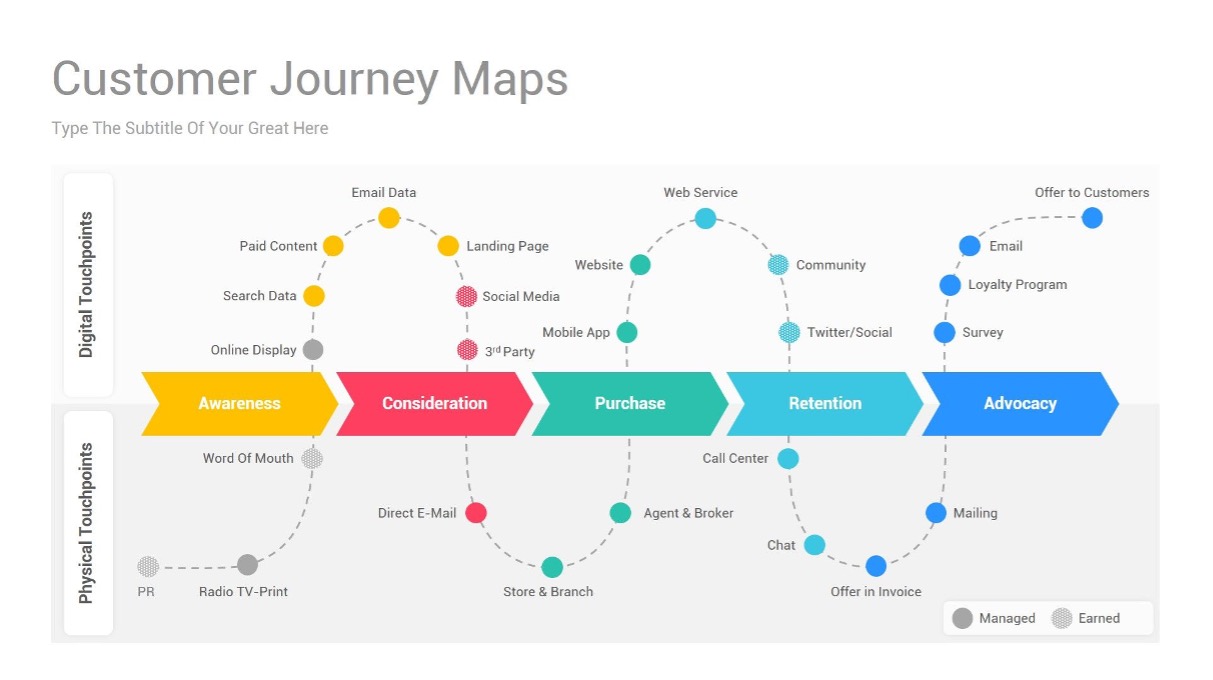Finding a desired product or service online resembles setting off on a journey. The customer needs to take the first step (open an internet browser) and go through several stages leading them to the solution – an offer that checks all the important boxes. In this post, we want to show you what the digital customer journey is about – what stages it comprises and how you can map it. Read on because it can give your online sales a real boost!
In short, effective sales is all about reaching the right person/company at the right time with the right offer. Of course, easier said than done; that’s why you need to prepare for that, and a digital customer journey is a good place to start.
Digital marketing customer journey: What do you need to know about it?
The customer journey in digital marketing is all about understanding your prospects and the steps they need to follow in order to become your customers/users. It describes how people discover your brand, select the best product/service, and purchase it. Depending on your offer and business profile, the digital customer journey can comprise several stages and touchpoints, but we can list five essential ones.
Read also: Beyond aesthetics: How design systems impact business?
Stage 1: Awareness
At this stage of the digital customer journey, the customer is actively looking for a solution to their problem. They have some questions and options to choose from. Your goal is to direct the potential customer to your website/store and show them how your company can solve the problem. At the awareness stage, marketing is paramount; after all, people must find out about your company. Therefore, you should concentrate on:
- Ads (e.g., Google Ads, Facebook Ads)
- Sponsored posts and guest posts
- SEO (to increase visibility in the search engine)
Tutorials, guides, and how-to materials are also useful. Try to diversify your message and tailor it towards different marketing channels.
Here’s an example of a video made by Artegence for Oriflame’s Youtube channel – Piękna tak jak chcę:
https://www.youtube.com/watch?v=3UNS7LZ112c
Stage 2: Consideration
At this stage of the digital marketing customer journey, the customer is considering various options and looking for an effective and affordable one. Here, you should convince the prospect that you know how to help them. You can do so through:
• Guides and comparisons
• FAQ and Q&A sections
• Case studies and customer reviews
• Before-after comparisons
Example: Why Volkswagen is a good choice? https://www.volkswagen.pl/pl/osobowe/dlaczego-warto-wybrac-volkswagena.html
Read also: Mobile apps in the service of mental health
Stage 3: Purchase
This stage is crucial; it’s when the customer clicks the “buy now” button. Of course, you should pay attention to this stage of the digital customer journey, especially in e-commerce, but in other sectors as well. At this point, your goal is to guide the buyer through the purchasing process, and this “trip” should be quick and easy. Things to consider at the purchase stage comprise:
• Access to various payment and delivery options
• The possibility of finishing the order without the need to open an account
• Full technical functionality of the cart section and the payment gate
• Transparency and intuitiveness of the purchasing process (no excessive actions to complete, no distractions, no unnecessary questions).
Stage 4: Experience
The customer has just ordered their product, and it’s on the way. As an entrepreneur, you want to ensure they receive their order and that they are satisfied with it. This phase of the digital customer journey can greatly influence the overall experience with your brand. Therefore, you ought to focus on:
• Quick and safe delivery
• Order tracking codes for your customers
• Help center for the first use of your product
• Follow-up communication (to ensure everything is fine)
Take a look at this example of a really good thank-you message:

Source: https://www.shopify.com/ca/blog/thank-your-customers
It brilliantly supplements the purchasing process and builds the great image of the brand, doesn’t it?
Read also: Software design process: don’t think software, think tools!
Stage 5: Retention
Usually, the customer digital journey does not end with the delivery of the product. After all, you want your customer to return to your company in the future, right? That’s what stage five is about. Maintain communication with your customers and remind them about your offer from time to time. You can do so through loyalty programs, newsletters, personalized product recommendations, and social media profiles. If you do it properly, you will gain customer loyalty.
For example, take a look at this Rewards program by Starbucks.
The digital customer journey map
To streamline managing and optimizing the digital customer journey, companies create maps depicting the whole process in the form of a flowchart or an infographic. Here’s a good example of such a digital customer journey map:

Source: https://www.nulivo.com/items/581/customer-journey-map-powerpoint-ppt-template
As you can see, it comprises the stages we mentioned above, along with the physical and digital touchpoints (moments and means of interaction between your brand and the prospect). To create a fully functional digital customer journey map, you need to start with a buyer persona (a profile of your ideal customer). It will help you understand your target audience’s expectations, needs, and habits (use web analytics tools and work with your team to create such a persona).
Secondly, you should list all the relevant touchpoints in your buying process, including:
• Your website/online store
• Web/mobile apps
• Newsletters
• Social media profiles
• Ads
And analyze what role they play in the digital customer journey. Each of these touchpoints should be optimized to help you close the deal. Lastly, put all that together in one flowchart. If you need additional data/resources, you can keep them in accompanying files (e.g., Excel spreadsheets).
The goal of every digital customer journey is to help your company guide your customers from the very beginning (when they are discovering your brand) right to the end (when they are returning to your company regularly to buy more). To make it possible, you need to see the process from the buyer’s perspective. Go through the entire process and ask yourself several questions:
• Is the purchasing process really easy and convenient?
• Does the website/store contain the answers to all relevant questions?
• Is everything functional from the technical perspective?
• What problems can our customers encounter when ordering products? How can we eliminate these problems and streamline the process?
This way, you will create a functional digital customer journey map that fits your business and answers the needs of your customers.
Read also: What is dark UX?





